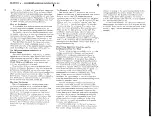
62
◆
◆
◆
◆
◆
◆
◆
◆
◆
◆
◆
◆
◆
◆
◆
◆
◆
◆
◆
◆
◆
◆
◆
◆
◆
◆
◆
◆
◆
◆
◆
◆
◆
◆
◆
◆
◆
◆
◆
◆
◆
●
Note Shift (Tuning Shft)
Range: -64 — +63
This determines the coarse pitch setting of the selected
drum sound.
●
Detune (Tuning Detn)
Range: -64 — +63
This determines the fine pitch setting of the selected drum
sound.
●
Note On Receive Filter (Note RcvOn)
Settings: off, on
This determines how the selected drum sound responds to
MIDI Note On messages. Normally, this should be set to
on so that the corresponding drum sound plays when a
MIDI Note On message is received. Set this to off when
you want to keep the selected drum sound from playing.
●
Note Off Receive Filter (Note RcvOff)
Settings: off, on
This determines how the selected drum sound responds to
MIDI Note Off messages. When this is set to on, the
selected sound will stop in response to the corresponding
MIDI Note Off message. An on setting is good for some
sustained sounds (like a whistle), or for key-controlled
cymbal “chokes.” For most drum sounds, however, this
should be set to off so that the drum sound plays back in its
entirety (is not cut off).
●
Alternate Group (Mode Alter)
Range: off, 1 — 127
This determines the group assignment of the selected drum
sound. Drums assigned to the same group cannot be
sounded simultaneously. In other words, if one drum in a
group is sounding while a second in the same group is
played, the first drum sound will be cut off and the second
will sound.
HINT: The main use for this parameter is in creating realistic
hi-hat sounds. By assigning an open hi-hat and a closed hi-hat
to the same group, you can “choke” or stop the open hi-hat
sound by simply playing the closed hi-hat — just like pressing
the pedal on an actual hi-hat set.
●
Instrument Assign Mode (Mode Asign)
Settings: single (sgl), multi (mlt)
This determines how the Voices are sounded when two or
more notes are played from the same key. When this is set
to single and the same key is played twice, the first note is
cut off as soon as the second note is played. When set to
multi and the same key is played twice, the first note
continues to sound and is overlapped by the second note.
Содержание QS300
Страница 1: ......
Страница 2: ......
Страница 3: ......
Страница 4: ......
Страница 46: ...42 ...
Страница 100: ...96 ...
Страница 108: ...104 ...
Страница 142: ...138 ...
Страница 166: ...162 ...
Страница 182: ...178 ...
Страница 207: ...203 Q S 3 0 0 APPENDIX Troubleshooting 204 Warning and Error Messages 206 Specifications 208 Index 209 APPENDIX ...
Страница 217: ......








































